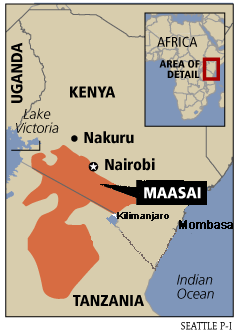Research
About the Community
For our project, we're focusing on a community within Tanzania, whose residents are a part of the Maasai people, a group that spans both Kenya and Tanzania. The group of people identifying as Maasai is rather large, with over one million people belonging to the Maasai group in the world today. We're working specifically with Lendikinya, where the nonprofit WAEV had already decided to focus before we established our project. The Maasai people have traditionally lived a semi-nomadic lifestyle, and in Lendikinya, raising livestock (cattle and goats) is combined with some agriculture (maize, pulses, and some fruits and vegetables) to meet food needs.
According to the Maasai Association, the Maasai people and their way of life are under threat thanks to different ideas of development brought about by outside countries and their home governments, as well as hurdles caused by the need to participate in today's modern economy, which doesn't align with more traditional practices, like communal land management. Formal schooling, while important for future opportunities for Maasai youth, has also disrupted traditional societal roles for young people (like herding cattle), and environmental issues like enhanced droughts due to climate change, deforestation, and erosion are posing challenges to the ways Maasai people have traditionally lived and farmed.
Since WAEV told us that the best way we could be of help to them is to assist in research for their programs aiming to bolster food production and empower Maasai women in the community through agriculture, our project and research largely focus on the food and nutrition aspects of the Lendikinya community. You can learn more about the community, and what WAEV's doing (and, by extension, we're researching) by reviewing a PDF that one of our partners at WAEV, Clif, has prepared here. Our project's end goal is to help set up WAEV with a website and related resources, as well as begin working on research that other groups can continue with in the future.
Explore the Area
The Maasai people live in an area that spans portions of both Kenya and Tanzania, situated on the adjoining borders of both countries. For our project, we're focusing on a group of Maasai living in the Lendikinya Village in Tanzania, situated near Monduli and Arusha.

A map of the Maasai people, courtesy of the Maasai Association. You can find the original file online at http://www.maasai-association.org/maasai.html.

A 3D terrain photo of Lendikinya Village (where the pin is dropped on the map) courtesy of Apple Maps. While the location isn't listed in Apple or Google Maps, you can use its GPS coordinates (3.33S 36.37E) to pinpoint it, or visit World Elevations, which does have map data for Lendikinya.
Demographics
While data isn't available for Lendikinya specifically, we've been able to find demographic information for both the Maasai people and for Tanzania as a whole, as well as some general information from observations by WAEV. You can find information about the roles of women and children in Lendikinya and overall family structure in the PDF linked above.
Population Trends
According to Ernestina Coast's paper Maasai Demography, published in 2000 at the University of London, looking at Maasai population trends in Tanzania is difficult (and largely inaccurate) thanks to sporadic government census surveys that, since 1967, have not identified the Maasai as a separate group. However, in that census, a total of 79,649 Maasai were recorded; considering their population in Tanzania is now estimated at around 381,000 people, their population growth is staggering, with a 478% increase over 50 years. Compounding the problem have been disputes over land that has traditionally been used by the Maasai people for grazing and migration, forcing them into conflict with wealthy landowners, the government, and conservation groups.
To learn more about demographics as a part of our research (malnutrition, child mortality, etc.), take a look at our Explore the Data page here.